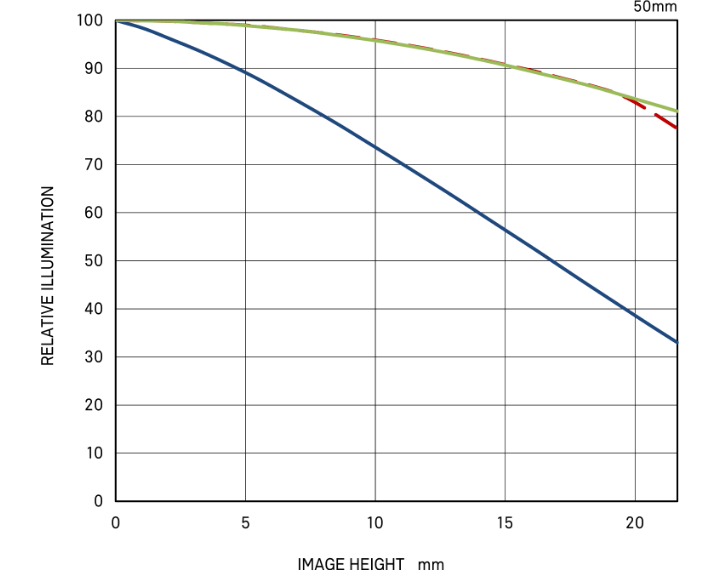

Art
50mm F1.4 DG HSM
Available mounts
- L-Mount
- Sony E-mount
- Sigma SA-mount
- Canon EF mount
- Nikon F mount
-
Camera Type
DSLR
-
Corresponding Mount
L-Mount, Sony E-mount, SIGMA SA-mount, Canon EF mount, Nikon F mount
-
Sensor Format
Full-frame [DG]
-
Lens Construction
13 elements in 8 groups
-
Angle of View
46.8°
-
Number of Diaphragm Blades
9 (Rounded diaphragm)
-
Minimum Aperture
F16
-
Minimum Focusing Distance
40cm / 15.7 in.
-
Maximum Magnification Ratio
1:5.6
-
Filter Size
φ77mm
-
Dimensions (Diameter × Length)
SIGMA SA-mount:φ85.4mm × 99.9mm / φ3.4in. × 3.9in.
Sony E-mount:φ85.4mm × 125.9mm / φ3.4in. × 5.0in.
L-Mount:φ85.4mm × 123.9mm / φ3.3in. × 4.8in.
*The length of a lens is measured from the filter surface to its mount.
-
Weight
SIGMA SA-mount:815g / 28.7oz.
Sony E-mount:880g / 31oz.
L-Mount:905g / 31.9oz.
-
Edition Number
A014
The three-digit code on the surface of the lens is to indicate the year the lens was first released.
(Since it is different from the year of manufacture, the release year and edition number may not match depending on the mount.) -
Supplied Accessories
・Case
・LENS HOOD LH830-02
・FRONT CAP LCF-77mm III
・REAR CAP LCR II -
Mount / Product Barcode
SIGMA SA-mount:00-85126-31156-8
Nikon F mount:00-85126-31155-1
Canon EF mount:00-85126-31154-4
Sony E-mount:00-85126-31165-0
L-Mount:00-85126-31169-8
-
Camera Compatibility
LINK
-
* This product is developed, manufactured and sold based on the specifications of E-mount which was disclosed by Sony Corporation under the license agreement with Sony Corporation.
* L-Mount is a registered trademark of Leica Camera AG.
* SONY A-mount have been discontinued in production.
-
Offering the best 50mm F1.4 performance in the history of photography,this is the ultimate standard lens
Putting all of our largeaperture lens development know-how into this lens, we’ve minimized optical aberrations and achieved the very highest level of optical performance.
A 50mm F1.4 large-aperture lens offers an angle of view similar to human vision, a beautiful bokeh effect, and expressive versatility. It’s a basic specification that lets photographers take many different approaches to their craft. For this very reason, it demands a high level of fundamental performance. Sigma has designed lenses especially for digital SLRs since they first appeared on the market. In 2008, we first introduced the Sigma 50mm F1.4 EX DG HSM. Although compared to the lenses of today it had a fairly large body, this lens offered uncompromising performance and embodied our ideal of the standard lens. Until this time, only camera manufacturers had produced a lens in this specification for DSLRs. Our version of this go-to lens created quite the stir at first. Earning the support of photographers with its exceptional performance, it has become one of our representative lenses. The Sigma F1.4 DG HSM fulfills our design concept and quality requirements at the highest level. While producing a beautiful bokeh effect, it features exceptional peripheral brightness and minimal distortion. Uncompromising in every detail, this large-aperture standard lens offers the ultimate in image quality. Its high resolution makes it perfect for the high-megapixel era. Resolution is extremely crisp at the area in focus, while both front and rear bokeh are silky-smooth. Offering the ultra-high performance that characterizes our Art line, this lens inherits the design principles of the line’s first model, the flagship Sigma 50mm F1.4 DG HSM.
-
High resolution plus outstanding bokeh
While maximizing resolution at the area in focus, this lens offers a silky-smooth bokeh affect to the front and rear. To achieve exceptionally crisp resolution, we have minimized sagittal coma flare, chromatic aberration, and every other type of optical aberration that affects image quality. The result is minute detail without bleeding or streaking, even at wide-open aperture. Moreover, we have also minimized both vignetting and color streaking to the front and rear of the area in focus, thereby establishing a bokeh effect that is natural and aesthetically pleasing.
-
Minimized sagittal coma flare
An ideal large-aperture standard lens offers outstanding image quality across the image plane, even at wide-open aperture. Sagittal coma flare is an optical aberration in which point light sources near the image periphery have a tail (“coma”) instead of appearing round. To minimize this aberration, we have included a precision-molded aspheric lens element in the rearmost lens group. Since it minimizes the streaking of point light sources near the edge of the image, this lens is an excellent choice for shooting heavenly bodies and nighttime illumination. In addition, its beautiful bokeh effect makes it a great go-to lens for portraits, interior shots, and many other applications.
-
Minimized axial chromatic aberration
Axial chromatic aberration is difficult to correct after a photograph is taken using image processing software. For this reason, this lens features SLD (Special Low Dispersion) glass to minimize axial chromatic aberration and deliver sharp, high-contrast image quality throughout the frame.
-
Minimized distortion
Distortion is an optical aberration in which straight lines appear bent or curved. Since adjusting the focus cannot correct this aberration, it must be minimized at the design stage. This lens features aspheric lens elements and an optimized power distribution to minimize distortion from the center of the frame all the way to the edges.
-
High peripheral brightness
Large-aperture lenses are prone to reduced peripheral brightness. In this lens, we have made the forward lens group large-aperture, thereby raising aperture efficiency. The result is minimal reduction of brightness at the image periphery and even image quality throughout the photograph. Even at the wide-open aperture, you can shoot a blue sky without fear of reduced brightness and achieve a beautiful bokeh effect at the same time.
The x-axis represents image height (distance from center of image in mm), and the y-axis represents the relative illumination at the edge of the image (with illumination at the center of the image defined as 100%). When relative illumination is low, the corners of the image appear dark, resulting in vignetting.
-
The finest in materials, usability and functionality
A refined, integrated design made with the photographer in mind.
All lenses in Sigma’s new Art line come with a hood with a high-quality rubberized connector and feature a newly designed lens cap and AF/MF switch, and are designed for intuitive use and superior functionality. Inside, HSM (Hyper Sonic Motor) delivers high AF speed and extremely quiet performance. An enhanced algorithm offers even smoother automatic focusing. Full-time manual focus override is another key feature that leaves the artistic touches in the photographer’s hands. The brass mount combines high precision with rugged construction. Its treated surfaces and enhanced strength contribute to the exceptional durability of the lens. In both the external and internal parts, the optimized use of TSC (Thermally Stable Composite), an excellent match for metal parts, further contributes to the high-precision construction of the lens. In addition, the last three digits of the year the lens was offered for sale are engraved on the barrel for ease of reference.

-
HSM(Hyper Sonic Motor)
HSM (Hyper Sonic Motor) delivers high AF speed and extremely quiet performance. An enhanced algorithm offers even smoother automatic focusing. Optimizing AF algorithm, smoother AF is achieved. Also, new firmware offers full-time MF function by rotating the focus ring of the lens while auto focusing. Without changing the AF/MF Focus Mode Switch, it allows faster focus adjustment.
* The default setting of Full-time MF function varies for each mount.
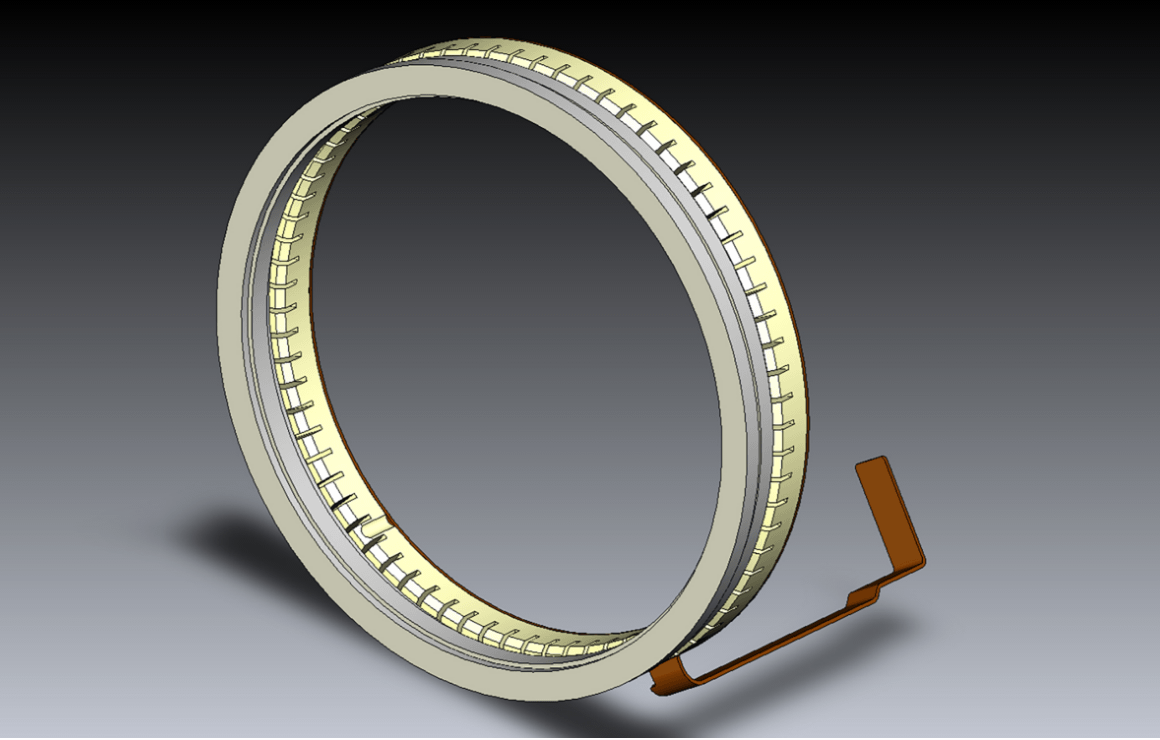
-
Minimum focusing distance of just 40cm
Sigma’s floating system adjusts the distance between lens groups during focusing, thereby reducing the amount of lens movement required. The result is less aberration at different shooting distances. Thanks to this system, this lens offers a minimum focusing distance of just 40 cm, a maximum magnification ratio of 1:5.6, and superb image quality at every shooting distance.
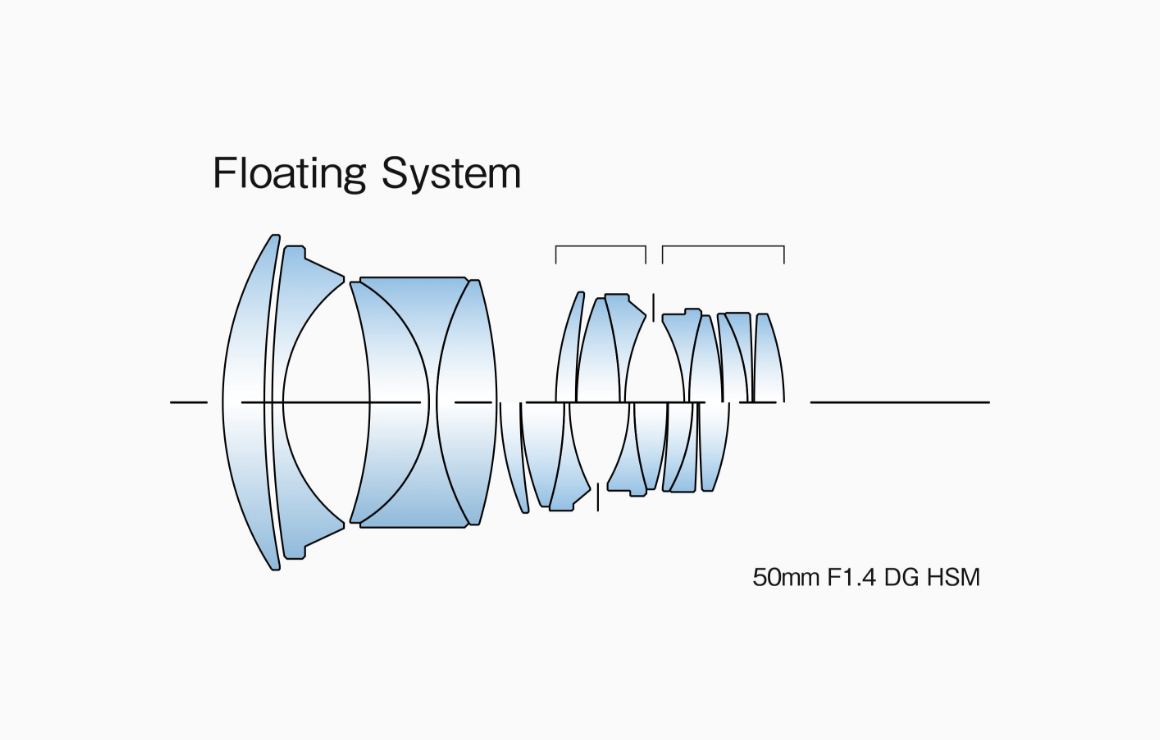
-
Rounded diaphragm
When photographing with point light sources such as electric lights or reflections on a body of water in the background, the rounded 9-blade diaphragm helps produce an attractive bokeh effect—even at large-aperture settings.
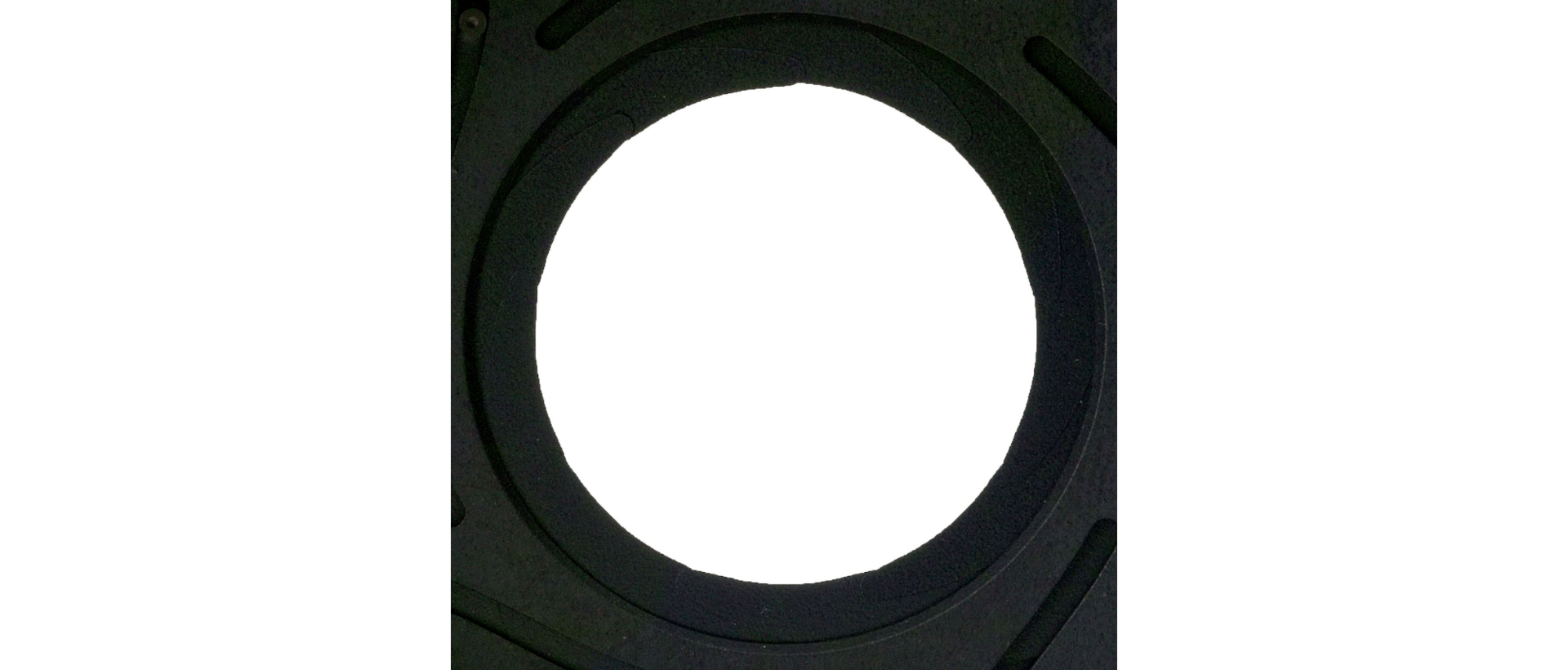
-
TSC (Thermally Stable Composite)
Conventionally it is considered essential to leverage the qualities of metal and polycarbonate in camera and lens layout design. A first for the industry, the barrel of the new series of Sigma lenses features a new
(*)TSC (Thermally Stable Composite) that offers minimal thermal shrinkage combined with exceptional hardness. It also offers 25% greater elasticity than polycarbonate. Since its thermal shrinkage is low, TSC matches well with metal parts, further contributing to the high-precision construction of the lens.(*)TSC (Thermally Stable Composite)
TSC (Thermally Stable Composite) is a type of polycarbonate with a thermal expansion rate similar to that of aluminum. It has high affinity to metal parts which contributes to high quality product manufacturing. -
Flare and ghosting reduction
From an early stage in the lens design process, flare and ghosting have been measured to establish an optical design resistant to strong incident light sources such as backlighting. Sigma’s Super Multi-Layer Coating reduces flare and ghosting to help photographers produce sharp and high contrast images even in backlit conditions. The included lens hood can be attached to block out extraneous light, which can have a negative effect on rendering performance.

-
High-precision, rugged brass bayonet mount
The brass mount combines high precision with rugged construction. Its treated surfaces and enhanced strength contribute to the exceptional durability of the lens.
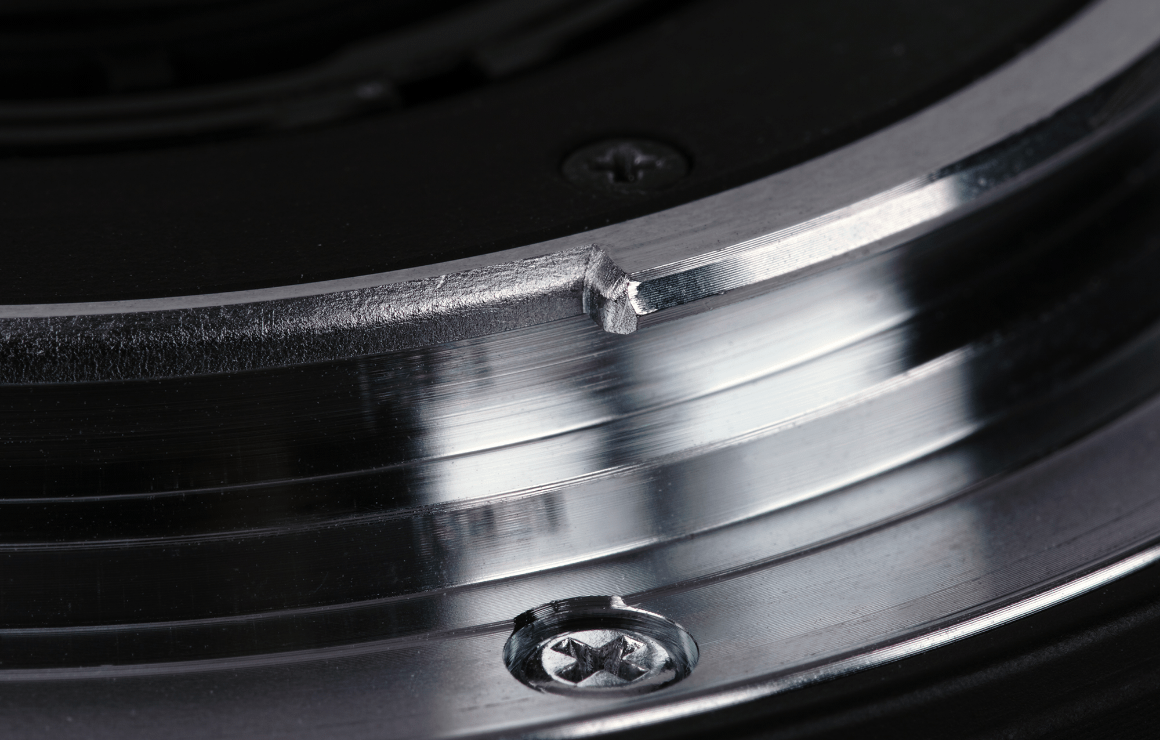
Lens construction
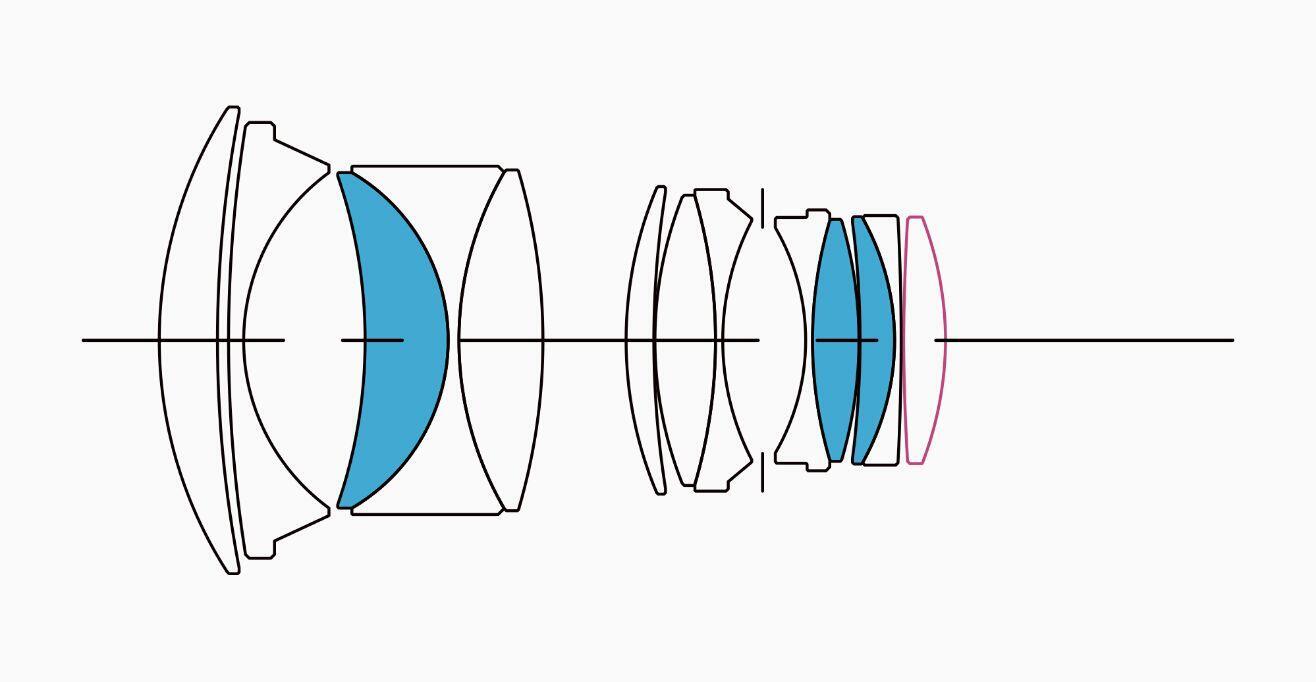
SLD glass
Aspherical lens
MTF Chart
The MTF (Modulation Transfer Function) is one of the measurements for evaluating a lens’ performance, and it shows how faithfully the contrast of the subject can be reproduced on the image plane. The horizontal axis shows the image height (distance from the center of the image in mm) and the vertical axis shows the contrast value (maximum value is 1).
The closer the 10 line pairs/mm curve is to 1, the higher the contrast and clarity of the lens is, and similarly, the closer the 30 line pairs/mm curve is to 1, the better the resolution and sharpness of the lens is.
*The MTF chart depicts the result at the wide-open aperture.
*For mirrorless lenses that support distortion correction, the horizontal axis shows the image height equivalent to when an L-Mount lens is attached to a Sigma L-Mount camera with distortion correction applied. (The effect of distortion correction may differ depending on the mount and camera used.)
*The spatial frequency indicates the variation on the image plane before distortion correction is performed.
-
Spatial frequency
S:Sagittal Line
M:Meridional Line
-
10lp/mm
-
30lp/mm
Diffraction MTF
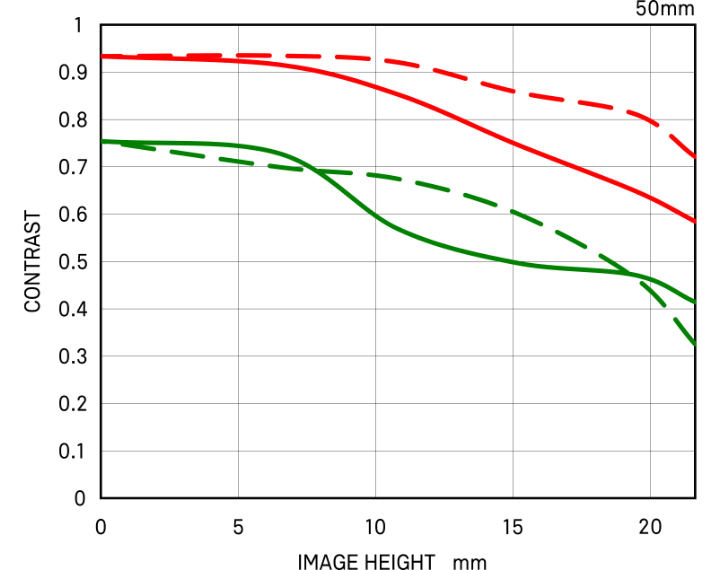
Geometrical MTF
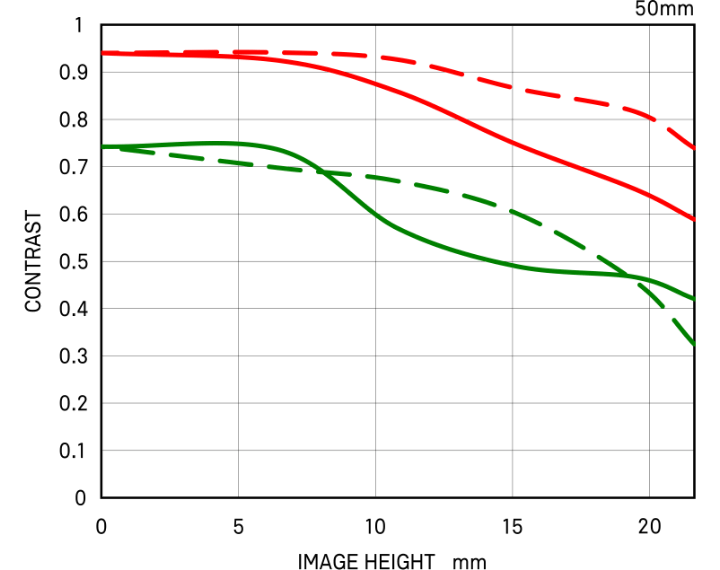
Distortion
effective distortion
When you take a picture of a lattice pattern, it will appear as the blue dotted line shows. The red line illustrates how the lattice pattern will appear in the actual picture when any lens distortion is taken into account.
relative distortion
In this chart, the horizontal axis shows the ideal image height (the distance from the center to the edge of the image [mm]). The vertical axis shows the extent of distortion. The extent of distortion is represented by how much Y, which is the actual image height, grows (or shrinks) against Y0 which is the ideal image height.
When you take the picture of a square object, if the distortion amount shows a minus value, the image will be seen as expanded (Barrel distortion). If the distortion amount is a plus value, it will be seen as a recessed (Pincushion distortion). When the distortion value is close to 0, the appearance of distortion is very minimal.

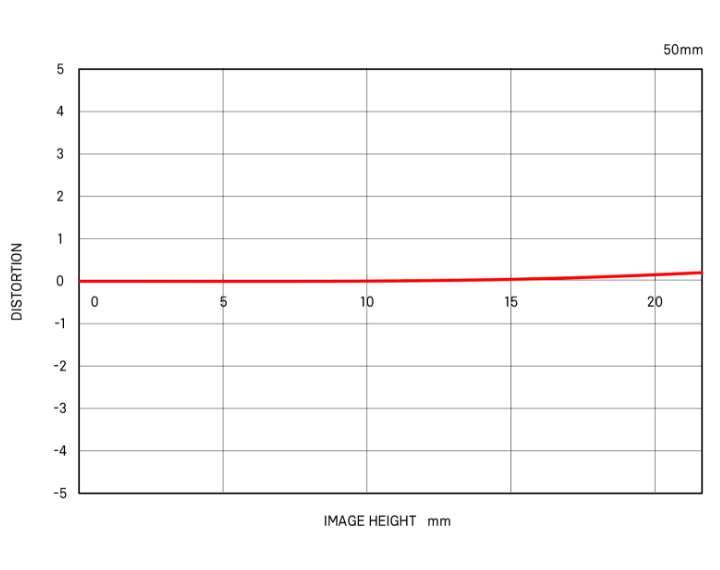
Vignetting
The horizontal axis shows the image height (the distance from the center to the edge of the image [mm]).The vertical axis shows the amount of light in the image (based on the amount of light in the image center being 100%). If the peripheral amount of light is lower than the center, the four corners of image will be darker (vignetting).
-
F1.4
-
F2.8
-
F5.6
